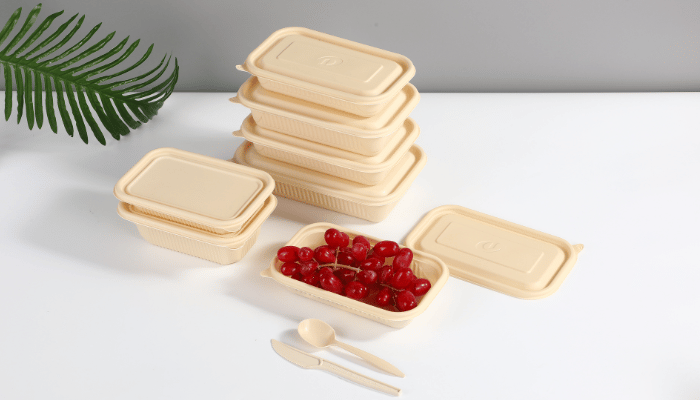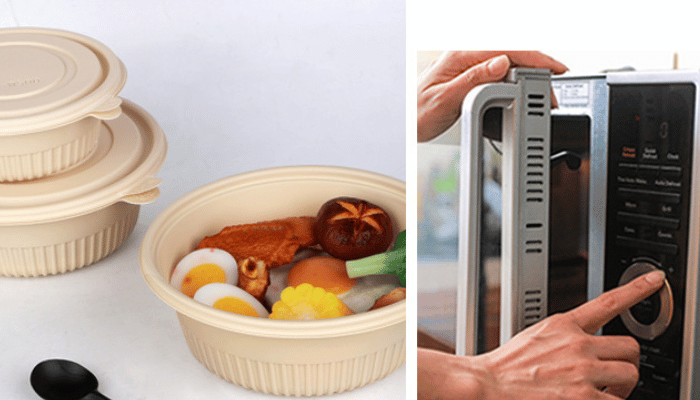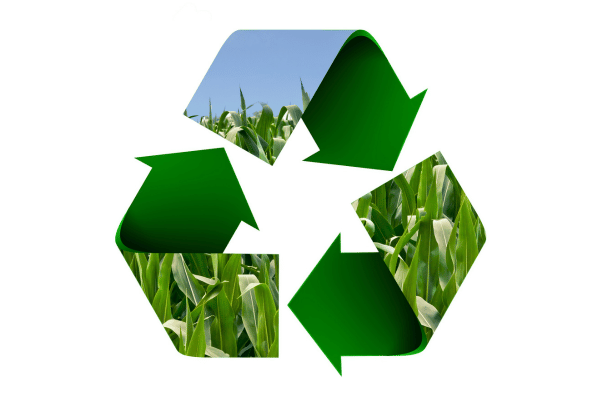In recent years, there has been growing concern about the environmental impact of traditional packaging materials, especially plastics. As a result, researchers have been exploring alternative, sustainable packaging materials. One innovative solution that has received a lot of attention is cornstarch packaging. This article will take an in-depth look at cornstarch packaging, examining its environmental benefits, production process, applications, and potential challenges.
What is Cornstarch Packaging?
Biodegradable packaging refers to materials that can break down naturally over time, returning to the environment without causing harm that can replace polystyrene and plastic. Understanding the decomposition process is crucial for assessing the eco-friendliness of packaging. Cornstarch packaging has various purposes, but the most common use of it is for take-out food.

Environmental Benefits of Cornstarch Packaging
Biodegradability
Cornstarch is a biodegradable material, which means it can break down naturally over time with the help of microorganisms. By contrast, conventional packaging materials, such as plastics and styrofoam, persist in the environment for centuries, leading to pollution, habitat destruction, and harm to wildlife. This is in stark contrast to cornstarch packaging which has been in the environment. The detrimental effects necessitate a shift towards sustainable alternatives.
Renewable Resources
One of the key environmental benefits of cornstarch packaging is its reliance on corn, a renewable resource. Corn can be cultivated annually, providing a sustainable and readily available source of raw material. This stands in stark contrast to traditional plastics, which are derived from finite fossil fuels. The use of renewable resources in cornstarch production supports agricultural practices that contribute to soil health, biodiversity, and overall ecosystem sustainability.
Reduced Carbon Emission
The production of this kind of packaging typically results in lower carbon emissions compared to the manufacturing processes involved in traditional plastics. Traditional plastics are derived from fossil fuels, and their production involves energy-intensive processes that release significant amounts of greenhouse gases into the atmosphere. In contrast, cornstarch production tends to have a lower environmental impact, contributing to the reduction of overall carbon emissions. This is particularly crucial in the context of global efforts to mitigate climate change and transition to more sustainable practices.

Production Process of Cornstarch Packaging
Cornstarch Extraction
The production process of cornstarch packaging begins with the extraction of starch from corn kernels. Corn kernels undergo a series of steps including grinding, soaking, and separation. The process involves milling corn kernels into a fine powder, followed by soaking to separate the starch from other components such as proteins and fibers. Mechanical and chemical methods are employed to isolate the starch, resulting in purified cornstarch ready for further processing.
Biopolymer Formation
Once extracted, the cornstarch serves as the primary raw material for the formation of biopolymers, which are the fundamental building blocks for cornstarch-based packaging materials. Various processing techniques are employed to transform the extracted cornstarch into biopolymer resins suitable for packaging applications. Extrusion and injection molding are common methods used to shape and form biopolymers into a variety of packaging products, ranging from films and sheets to molded containers.
Blending and Additives
To enhance the mechanical properties of cornstarch-based packaging materials, blending with other biodegradable polymers or incorporating additives is a crucial step. Blending allows for the customization of material properties, such as flexibility, durability, and moisture resistance, to meet specific packaging requirements. Other biodegradable polymers, such as polylactic acid (PLA) or polyhydroxyalkanoates (PHA), may be blended with cornstarch to achieve the desired characteristics. Additionally, the incorporation of additives, such as plasticizers or reinforcing agents, further improves the overall performance of the packaging material.
Applications of Cornstarch Packaging
Single-Use Products
Cornstarch packaging finds extensive use in the production of single-use items, offering a sustainable alternative to conventional plastics. Disposable cutlery, plates, and cups made from cornstarch-based materials have gained popularity due to their biodegradability and reduced environmental impact. These single-use products serve as eco-friendly choices for events, gatherings, and take-out services, contributing to the reduction of plastic waste in various settings.
Food Packaging
Cornstarch-based films and coatings play a crucial role in the realm of food packaging. These materials are employed to create biodegradable and compostable packaging solutions, providing an environmentally friendly alternative to traditional plastic packaging. Cornstarch-based films can be utilized to wrap and protect a variety of food products, extending their shelf life and helping to maintain freshness. This application aligns with the growing consumer demand for sustainable packaging in the food industry, reducing the overall environmental footprint of packaged goods.
Agricultural Applications
Cornstarch’s versatility extends to agricultural practices, where it is employed in various applications contributing to sustainable farming practices. Cornstarch is used in the production of mulch films, providing a biodegradable alternative to conventional plastic mulches. These films help in weed control, moisture retention, and temperature regulation in agricultural fields. Additionally, cornstarch-based seed coatings offer a sustainable solution for enhancing seed performance, promoting optimal germination, and supporting eco-friendly farming practices. These applications showcase the potential of cornstarch to mitigate environmental impacts associated with traditional agricultural materials.

Challenges and Considerations
Cost
The production cost of cornstarch-based packaging remains a primary hurdle for widespread adoption. Compared to traditional plastics, it can be more expensive, impacting its competitiveness in the market. Researchers and industry leaders actively engaged in ongoing research and development efforts to optimize production processes, improve efficiency, and find cost-effective solutions. Addressing this challenge is crucial to ensuring that cornstarch-based packaging becomes a financially viable and attractive alternative.
Performance Limitations
Cornstarch-based materials, while offering biodegradability and sustainability, may encounter limitations in specific performance aspects. Issues such as heat resistance and water resistance are areas of concern, particularly in applications where durability is paramount. Ongoing research endeavors focus on enhancing the overall performance characteristics of cornstarch-based packaging, aiming to broaden its scope of applications and compete more effectively with conventional materials. Advancements in formulation and processing techniques are key to overcoming these performance limitations.
Land Use and Agricultural Practices
The large-scale cultivation of corn for packaging materials raises environmental and ethical considerations. Concerns include potential changes in land use patterns, the risk of monoculture, and the use of fertilizers and pesticides in corn farming. To address these challenges, a shift toward sustainable agricultural practices is imperative. This involves promoting responsible sourcing of corn, employing eco-friendly cultivation methods, and considering alternative feedstocks for cornstarch production. Collaboration between the packaging industry and agricultural stakeholders is essential to ensure that cornstarch-based packaging aligns with sustainable and ethical principles.
Consumer Awareness and Acceptance
The success of cornstarch-based packaging relies on consumer awareness and acceptance. Educating the public about the environmental benefits of such packaging materials, as well as dispelling any misconceptions, is crucial. Marketing efforts should highlight the positive impact of choosing cornstarch-based alternatives, fostering a consumer mindset that prioritizes sustainability over conventional choices. Building trust and confidence in the performance and environmental benefits of cornstarch-based packaging is essential for its successful integration into mainstream markets.

Future Prospects and Trends
Emerging Technologies in Cornstarch Packaging
Nanotechnology involves manipulating materials at the nanoscale to enhance their properties. In the realm of cornstarch-based packaging, researchers are incorporating nanomaterials into the matrix to create nanocomposites. Compared to traditional cornstarch-based materials, these nanocomposites exhibit improved mechanical strength, barrier properties, and flexibility. Nanoparticles, such as cellulose nanofibers or clay nanoparticles, are being used to reinforce the structure of the packaging, making it more resilient and adaptable for various applications.
Another application of nanotechnology involves applying nanoscale coatings to the cornstarch-based packaging. These coatings can enhance the material’s resistance to moisture, gases, and UV radiation, thereby extending the shelf life of packaged products. Nanocoatings also contribute to the overall durability and performance of cornstarch-based packaging, making it a more viable option.
At last, the integration of nanotechnology and bioengineering into cornstarch-based packaging holds tremendous potential for revolutionizing the packaging industry. These innovations not only enhance the performance of cornstarch-based materials but also contribute to reducing the environmental impact of packaging waste. However, scalability, cost-effectiveness, and regulatory considerations need to be addressed to facilitate the widespread adoption of these emerging technologies.
Conclusion
Cornstarch packaging presents a promising alternative to traditional plastics, offering biodegradability, renewability, and reduced carbon emissions. As research and development in this field continue, addressing challenges related to cost and performance will be pivotal in ensuring widespread adoption. The journey towards sustainable packaging is ongoing, and cornstarch packaging stands at the forefront of this environmental revolution.



